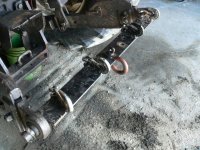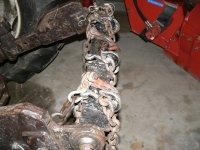You are using an out of date browser. It may not display this or other websites correctly.
You should upgrade or use an alternative browser.
You should upgrade or use an alternative browser.
Skidding logs
- Thread starter Tollster
- Start date
- Views: 33735
More options
Who Replied?
/ Skidding logs
#71
deezler
Elite Member
- Joined
- Jan 30, 2012
- Messages
- 3,858
- Location
- Southeast MI
- Tractor
- Cub Cadet 7305, Kioti CK3510seh TLB
here is the rig I baked up. I use it when I have a few quick pulls to do and don't need to rig up the farmi skidding winch.
Looks pretty functional to me!
For a log skidding newb such as myself, are any 3-pt arm plates like this available retail? No welding skills or equipment here, sadly.
Gordon Gould
Super Member
- Joined
- Apr 1, 2007
- Messages
- 6,685
- Location
- NorthEastern, VT
- Tractor
- Kubota L3010DT, Kubota M5640SUD, Dresser TD7G Dozer
See posts 18 and 34. You can get a cross draw bar and tractor hooks at TSC. Post 18 shows these parts and in post 34 Arrow shows the same parts mounted on his tractor. Dead Horses unit is a a little nicer in that he has welded on grab hooks to the cross draw bar instead of using pin on tractor hooks. So he gains a little height. He has also made his so it does no rotate which might make it easier when rigging up.
3238dpw
Gold Member
- Joined
- Nov 12, 2006
- Messages
- 360
- Location
- Central NJ
- Tractor
- Power Trac 425, C-121 Wheel Horse, 2 Exmark 60 inch zero turn mowers
This is my favorite idea
[ame=http://www.youtube.com/watch?v=6IlfQ89fGzs&feature=channel]New Cat 1 tong demo.avi - YouTube[/ame]
[ame=http://www.youtube.com/watch?v=6IlfQ89fGzs&feature=channel]New Cat 1 tong demo.avi - YouTube[/ame]
Dead Horse
Platinum Member
for reference here is the way the rig is lashed down so it does not rotate. This is very important in ensuring a consistent hook up and pull. keeps the chain from backing out of the hook, and keeps the bar from swing back and forth during the pull.
choker chains hook right up tight. I back the rig up to the logs, drop the bar right down on the logs, hook up tight and raise the lift enough to get the butts off the ground. Then off we go.
choker chains hook right up tight. I back the rig up to the logs, drop the bar right down on the logs, hook up tight and raise the lift enough to get the butts off the ground. Then off we go.
Attachments
goeduck
Super Star Member
GREAT tip, thank you.Here's a schematic of the Coos Bay cut, which can be used to take down a leaning/loaded tree without threat of barber chairing.
Creamer
Elite Member
Here's a schematic of the Coos Bay cut, which can be used to take down a leaning/loaded tree without threat of barber chairing. This is out of my notebook of felling tricks:

Cut #1 is a slightly shallow notch or face cut (maybe 20% diameter). Cuts #2 and #3 come in from the side and can be stabilized by wedges as needed. Cut #4 is your final back cut.
The Coos Bay removes outer holding wood that acts or leverages against the central grain to create shear, and also removes much of the central grain, only leaving a hinge and small perpendicular back strap that forms a "T". You can cut away at that back strap and the tree will gradually begin to go over. There may be a mini barber-chair within the small strap, but it's been isolated to a small grain region far from the outer holding wood, so it's not of significance.
My personal experience is that the Coos Bay T is versatile given a range of tree and bar sizes you may run into, and it also slows down the final felling action for a bit more control. I even use this when cutting a downed tree with a large rootball attached, which can barber chair horizontally and/or violently swing the rootball back into the ground. With a Coos Bay, you can slowly control that cut (I'd still brace the rootball in most cases).
There is also a variation of this cut which replaces the T with an upside down triangle.
I am having difficulty imagining how to get cuts 2 & 3 lined up well enough to make 4. Of course I guess if they were off some the chain would just recut although if it was off just a little a it would make the chain run to one side.
Creamer
Elite Member
This is my favorite idea
[ame=http://www.youtube.com/watch?v=6IlfQ89fGzs&feature=channel]New Cat 1 tong demo.avi - YouTube[/ame]
That looks like a real slick idea!
Gordon Gould
Super Member
- Joined
- Apr 1, 2007
- Messages
- 6,685
- Location
- NorthEastern, VT
- Tractor
- Kubota L3010DT, Kubota M5640SUD, Dresser TD7G Dozer
I am having difficulty imagining how to get cuts 2 & 3 lined up well enough to make 4. Of course I guess if they were off some the chain would just recut although if it was off just a little a it would make the chain run to one side.
There are two things that make that cut safer on leaners. Barber chairing occurs because you have very strong tension across the entire tree which is holding the tree from tipping forward. At the hinge you have strong compression from the weight of the tree. As you make a conventional back cut the tension in the wood between your cut and the hinge increases because the cross section of wood holding the tree gets smaller. If the difference between the tension wood and compression wood at the hinge gets to large the tree splits apart vertically - barber chairs. When you make the coos cut the wood above the two side cuts are no longer attached to the butt. Therefore all the tension is relieved above the cuts. The tension is increased in remaining center wood. But, the thing that makes it safer and less apt to barber chair, is that there is no single line all the way across the tree with strong compression on one side and strong tension on the other. The second think that makes the coos work is that there is less wood to cut in the back cut so you can cut it faster. It takes time for the tension forces to build as you cut so the faster you cut the less time tension has to build.
Now to answer the question. The two cuts don't have to line up perfectly. They can be way off and you will still relieve the tension in the section of butt above them. This is the primary goal. But the closer they match the faster you can make your back cut which is the secondary goal.
If your bar is long enough you can bore all the way thru on cut 2 and then cut all the way back. Be careful boring thru that the hinge is right. This is my preferred method. But there is no single method you can use on every leaner. These methods are designed for solid trees with no signs of rot. Rot in the crown could well mean the tree is hollow. Be extremely careful !!!
gg
Creamer
Elite Member
There are two things that make that cut safer on leaners. Barber chairing occurs because you have very strong tension across the entire tree which is holding the tree from tipping forward. At the hinge you have strong compression from the weight of the tree. As you make a conventional back cut the tension in the wood between your cut and the hinge increases because the cross section of wood holding the tree gets smaller. If the difference between the tension wood and compression wood at the hinge gets to large the tree splits apart vertically - barber chairs. When you make the coos cut the wood above the two side cuts are no longer attached to the butt. Therefore all the tension is relieved above the cuts. The tension is increased in remaining center wood. But, the thing that makes it safer and less apt to barber chair, is that there is no single line all the way across the tree with strong compression on one side and strong tension on the other. The second think that makes the coos work is that there is less wood to cut in the back cut so you can cut it faster. It takes time for the tension forces to build as you cut so the faster you cut the less time tension has to build.
Now to answer the question. The two cuts don't have to line up perfectly. They can be way off and you will still relieve the tension in the section of butt above them. This is the primary goal. But the closer they match the faster you can make your back cut which is the secondary goal.
If your bar is long enough you can bore all the way thru on cut 2 and then cut all the way back. Be careful boring thru that the hinge is right. This is my preferred method. But there is no single method you can use on every leaner. These methods are designed for solid trees with no signs of rot. Rot in the crown could well mean the tree is hollow. Be extremely careful !!!
gg
Thanks Gordon! I have used the boring cut on trees that are large enough. I like the concept of that one better but like you say there are different situations and therefore different techniques to accommodate those situations.
As is normal I learned something today from this site!




